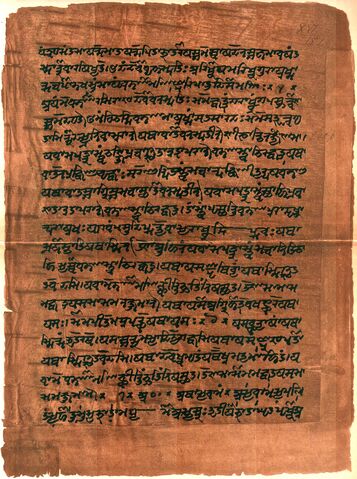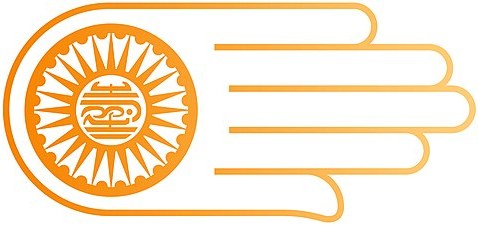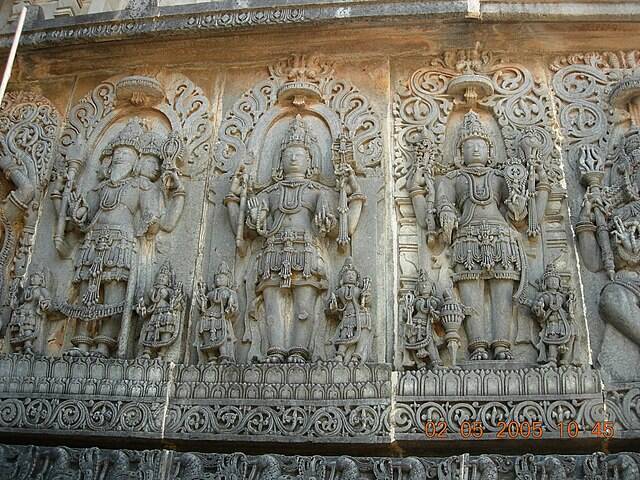How closely 1 do the Seen and the Unseen in our world match up? Do our beliefs in god(s) fit with what we know about the natural world? Simply, do religion and science cohere? Awhile back, I concluded that they do not cohere very well. And so I departed from my Christian faith.
But what about other religious traditions? Do the Hindu traditions, say, suffer similar existential onslaught from science that my Christianity suffered? To answer, I must learn more about Hinduism. So here is what I know thus far.2
Hinduism is the world's third-largest religion, with over 2.2 billion followers.[1] It is a diverse system of thought marked by a range of philosophies, cosmologies, and shared textual sources. Two important sources are the Agamas[2] and the Vedas.
The Vedas. The Vedas comprise a large body of religious text originating in ancient India.[3] The texts are the oldest layer of Sanskrit literature and the oldest scriptures of Hinduism. There are four Vedas: the Rig Veda, the Yajur Veda, the Sama Veda and the Atharva Veda. The Rig Veda was written 1500–1200 bce. The Yajur Veda, Sama Veda and Atharva Veda were written 1200–900 bce. Each Veda has four subdivisions: the Samhitas, the Aranyakas, the Brahmanas and the Upanishads.
The Upanishad subdivisions of the Vedas deal with meditation,
philosophy and ontological
knowledge.[4]
The Upanishads are commonly referred to as the Vedãnta,
which are variously interpreted to mean last chapters, parts of the Veda
or the highest purpose of the Veda
.

Orthodox vs heterodox. During the Shramanic Period (800–200 bce), the Vedic religious tradition split,[6] forming the orthodox pro-Vedic (ãstika) branch comprising the six orthodox Hindu schools, and the heterodox (nãstika) branch which includes Jainism, Buddhism, Sikhism, Charvaka and others. The three principles of Jainism are ahimsa (non-violence), anekantavada (non-absolutism) and aparigraha (non-attachment).[7] Charvaka was a school of thought which embraced materialism and hedonism.[8] It held that only direct perception, empiricism and conditional inference are proper sources of knowledge. It embraced philosophical skepticism, and rejected supernatural concepts like god, soul, afterlife, reincarnation and moksha (See below).
Hindu life. In Hinduism, the four aims of human life are:
Ahimsa is a key ethical principle in Hinduism,
Buddhism, Jainism and
Sikhism.[13]
Ahimsa advocates nonviolence to all creatures.
It is inspired by the premise that all living beings have the
spark of some divine spiritual vitality.
And so to hurt
another being is to hurt oneself. As an expression of
ahimsa, vegetarianism features
prominently in Jain culture.

Ahimsa
.[14]
Philosophy. The philosophical concepts of brahman (Ultimate Reality) and ãman (soul, Self) are central in Hindu thought,[15] and feature prominently in all the Upanishad subdivisions of the Vedas. Ãman is a Sanskrit word that refers to the Self or self-existent essence of human beings. Within Western religious sensibility, it is often loosely and perhaps incorrectly translated as the soul. The abovementioned six orthodox ãstika schools of Hinduism believe that there is ãman in every living being. In contrast, the heterodox nãstika branch posits no unchanging essence or Self to be found in the empirical constituents of living beings.[16]
The non-dualist Advaita Vedãnta tradition of Indian philosophy holds that the individual Self (ãman) and the primal Self or Ultimate Reality (brahman) are identical, and that all reality is an interconnected oneness.[17] Conversely, the dualist Dvaita Vedãnta tradition believes that ãman and brahman are distinct, existing as independent identities.
Param Brahma in Hindu philosophy is the Supreme Brahman
in that it is beyond all descriptions and
conceptualisations.[18]
It is described as the formlessness that eternally pervades
everything, everywhere in the universe and whatever is beyond.
In the Advaita Vedãnta tradition, Param Brahma
is synonymous with brahman, an
attribute-less Absolute. But in the Dvaita Vedãnta
tradition, Param Brahma is the attribute-endowed Absolute.
Deities. Trimurti is the triple deity of supreme divinity in Hinduism.[19] The members of Trimurti are Brahma (not to be confused with brahman),[20] Vishnu[21] and Shiva.[22] Trimurti personifies the cosmic functions of creation (Brahma), preservation (Vishnu) and destruction (Shiva). Many Hindu schools consider Buddha, Rama, Krishna and twenty-one other divine entities to be incarnations or avatars of Vishnu.

Download PDF on-hinduism.pdf (307 KB)